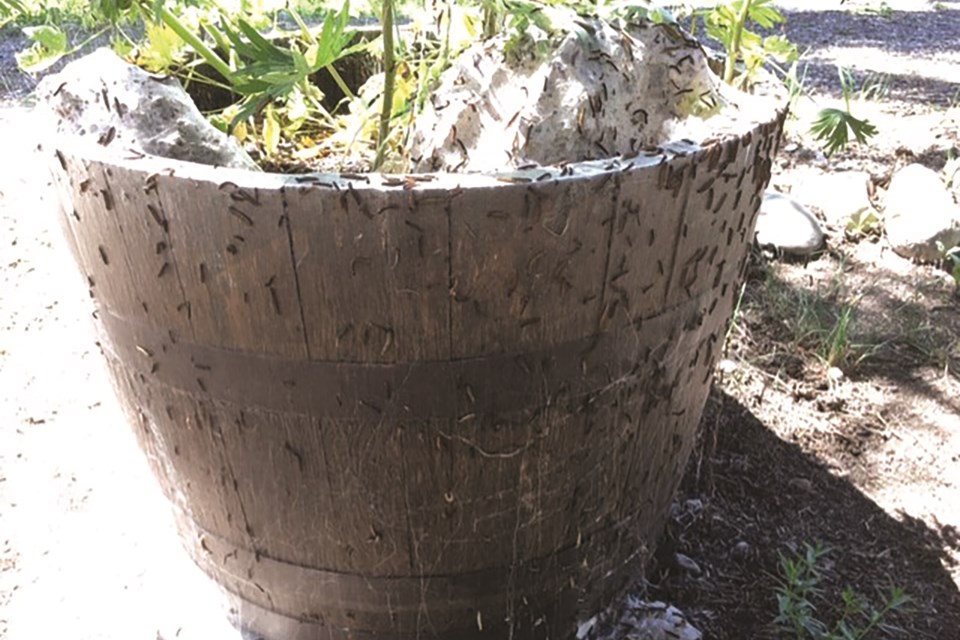Rocky View County is hoping a late spring and natural predators will help diminish a growing outbreak of spruce budworm in Bragg Creek because they will not be spraying for the insect in the coming year.
A budworm infestation, now deemed moderate to severe, will continue to be monitored next year by the county and the province.
The western spruce budworm is a native moth that feeds on fir and spruce trees in Canada’s western provinces. Canada’s cold weather, birds and insects, parasites and disease can keep the budworm population under control, however, when an outbreak occurs it can stretch over years and cause tree mortality, growth loss and timber defects in mature softwood forests.
At their Nov. 30 council meeting, Rocky View County councillors agreed with administration’s recommendation to manage the budworm issue in Bragg Creek using monitoring and assessing the infestation, rather than spray the insecticide BTK over the townsite.
Kristyn Lines, Agricultural and Environmental Services manager, told council the situation was at its worst this June and July, with the county receiving many complaints about larva and silk in people’s yards
“We have had one of most severe droughts of the past few decades,” Lines told council, adding a long cold snap, late spring and natural predators would help reduce the budworm population in Bragg Creek.
Rocky View County is working with the province to keep track of spruce budworm larva and adult moths, Lines said, adding the province doesn’t have plans to aerial spray on the Crown land around Bragg Creek.
Division 1 Coun. Kevin Hanson said if the province is not planning to spray, it does not make sense for the county to use that method either.
Lines said spraying can prolong an outbreak of spruce budworm.
“If there is a severe outbreak outside of Bragg Creek it could just move back in,” Lines explained.
Aerial spraying of BTK cost $1.2 million per application and two applications per season, would be needed, she told council.
Stands of trees can withstand five to seven years of severe spruce budworm outbreak before they start to become unhealthy and die, Lines said. The outbreak in Bragg Creek was first detected in 2019.
It is anticipated the larvae will continue to move west, but Lines said they will not know if that is the case until more surveying is done next year.
She said Rocky View County should follow the province’s lead in the plan for treating the infestation.
Bragg Creek resident Kym Binns’ trees and yard were overrun with spruce budworm larvae and its silk and feces this summer. Now she said the trees around her home are damaged from the bug.
“The trees are just emaciated and that is why we moved to Bragg Creek because of the beautiful Boreal forest,” she said.
Originally, she hoped the County would spray BTK like neighbouring Redwood Meadows but said she has learned that not all Bragg Creek residents will agree. This summer she circulated a petition and found about 90 per cent of residents wanted insecticide spraying.
“That 10 per cent that are against spraying, (the county) wouldn’t have their permission,” she said, explaining because the homeowners in Redwood Meadows lease the land from the Tsuut’ina Nation, they did not have a say in the decision.
Binns said her next move will be to try to form an ad hoc group that is interested in doing localized spraying for budworm.
“Maybe with the aid of Facebook, we can get something going and start in January and have some proactive measures,” she said. “We can order some BTK and bucket trucks and scissor lifts and do the best we can.”
It doesn’t look like the situation will improve if the weather remains dry and warm as it has this fall and winter, Binns said.
“It is not looking very good at all,” she said. “They like the dry weather. We are hoping to get out and spray as much as we can. It’s anybody’s guess what it is going to be like next year. The drought has really exacerbated it. Everything is just compounding with climate change so you just have to do what you can.”




